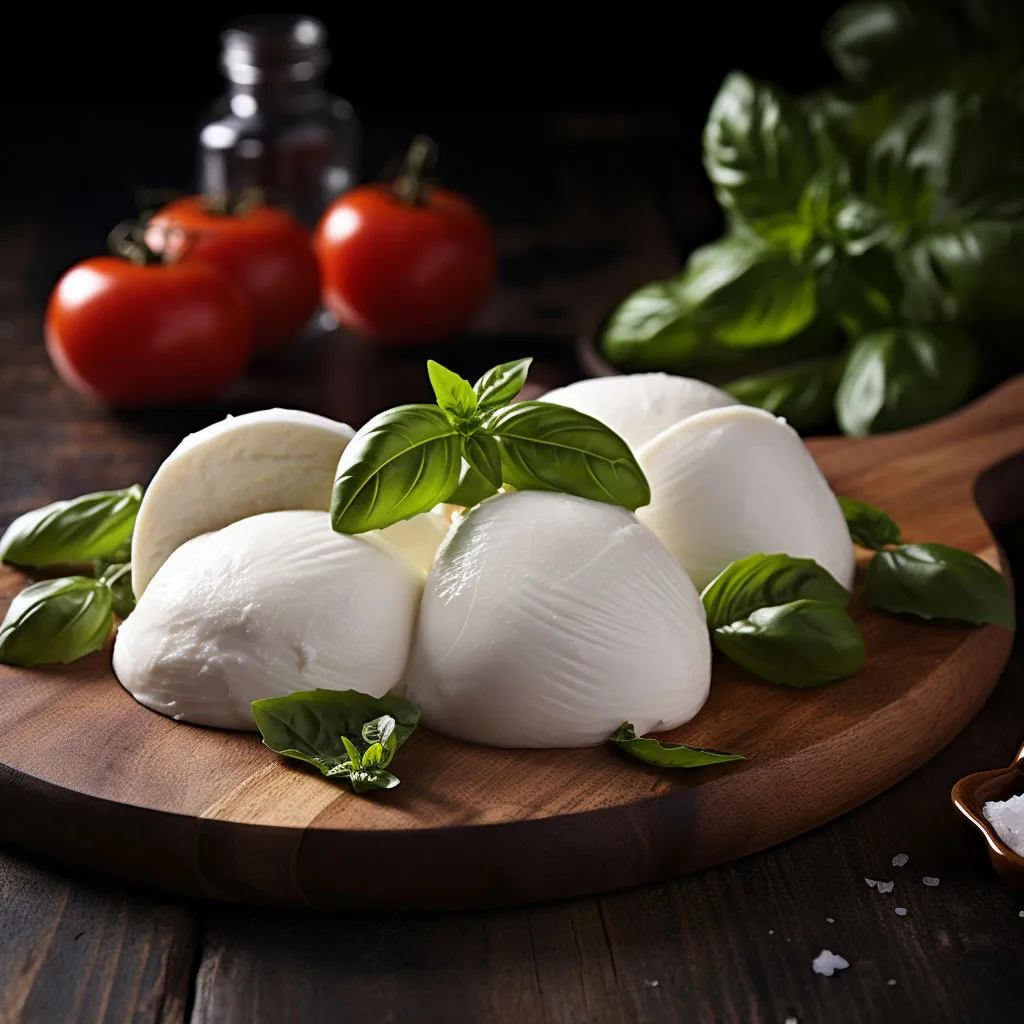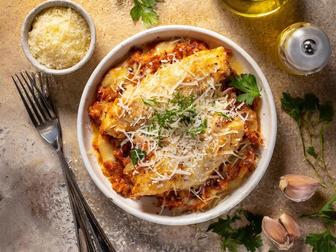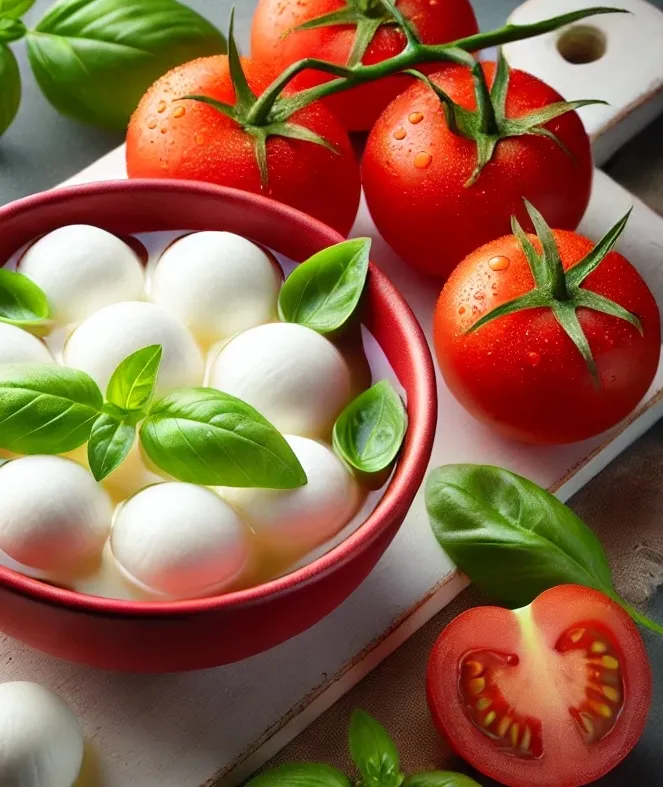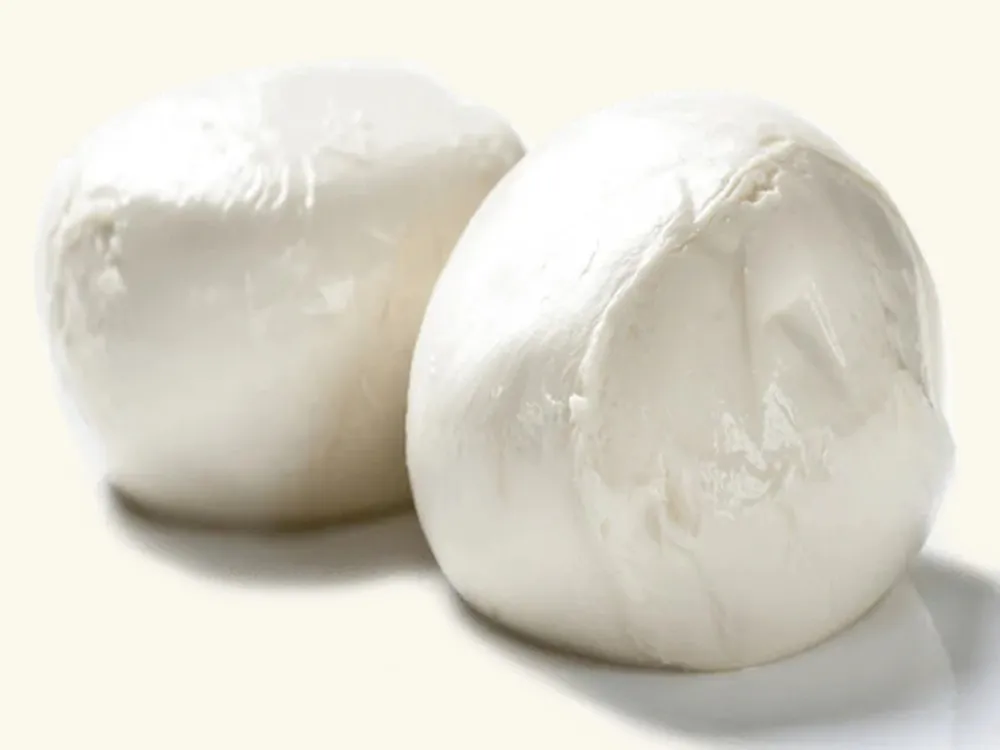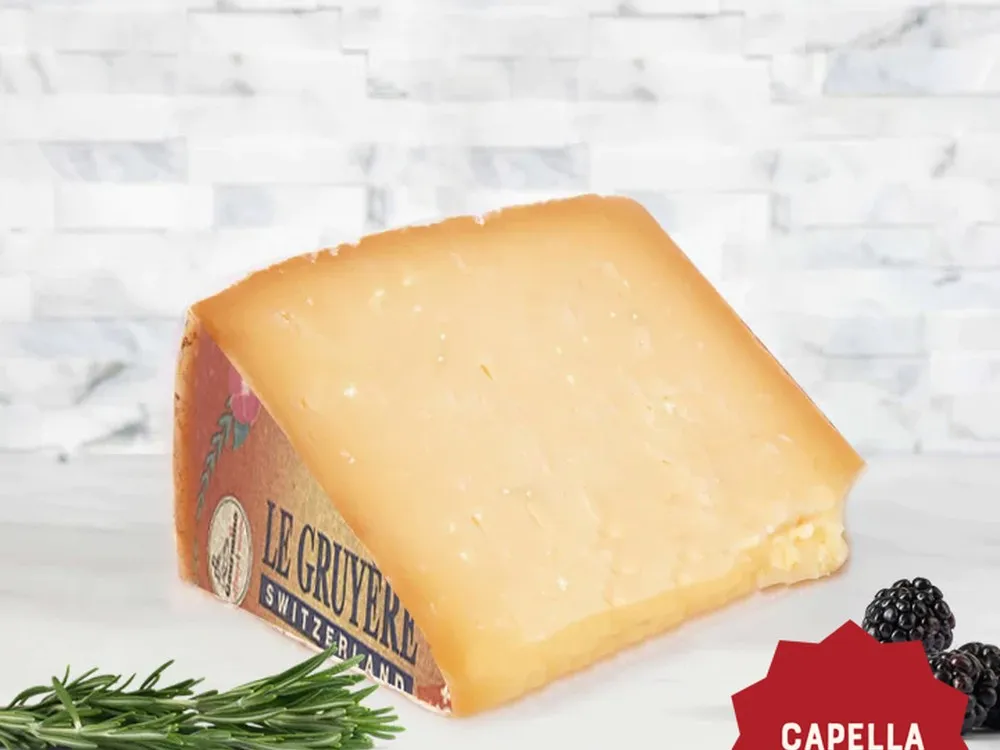Mozzarella
What is Mozzarella? How to Make Mozzarella Cheese?
Mozzarella cheese is a popular type of cheese known for its smooth, creamy texture and mild flavor. It is commonly used in Italian cuisine, particularly pizza, pasta, and salads. It is a semi-soft cheese made using cow's milk or buffalo milk, but some variations are made from goat or sheep milk as well. If you have ever wondered about the origins of mozzarella cheese, its nutritional value, or even how to pronounce it correctly, you’re in the right place to find out.
The cheese is traditionally made from Italian buffalo's milk using a method known as “pasta filata”. It is made by heating the milk, adding rennet to coagulate it, then stretching and kneading the curds. The cheese is shaped, brined, and packaged, resulting in a slightly sweet taste and soft, stretchy, and elastic texture.
It is available in the form of balls of different sizes.
Mozzarella di Bufala, also known as 'buffalo mozzarella', is made from Italian water buffalo milk.
Mozzarella Fior di Latte is produced from fresh, pasteurized, or unpasteurized cow's milk, while low-moisture mozzarella is made from whole or partly skimmed milk.
Mozzarella affumicata is a smoked variety of mozzarella.
Ciliegine is a traditional Italian type of mozzarella made with pasteurized cow's milk or sometimes with water buffalo's milk and is available in small smooth white balls.
Mozzarella made from sheep's milk by adding lamb rennet is called mozzarella pecorella or mozzapecora, in Sardinia, Abruzzo, and Lazio.
Mozzarella is also produced from goat's milk.
Where Does Mozzarella Come From?
Mozzarella cheese originated in Italy, mainly in the region of Campania, which includes cities like Naples. It has been produced in this region for centuries, using traditional methods handed down through generations. Today, mozzarella is made in many parts of the world, but Italy remains renowned for its high-quality, authentic mozzarella cheese. Since 1996, mozzarella has been recognized as a Traditional Specialty Guaranteed (TSG/STG) food product in the EU.
How To Make Mozzarella Cheese?
Fresh mozzarella is one of those easy-to-make-at-home cheeses to serve with salads, meats, seafood, and vegetables.
For some, the thought of making cheese might seem daunting; there is something almost mystical about the chemistry of cheesemaking. Thankfully, some cheeses are easier to make than others, and making your own mozzarella at home can be fun and satisfying and requires little specialized equipment.
-
Heat milk in a large pot until it reaches 90 degrees Fahrenheit.
-
Add citric acid diluted in water to the milk and stir gently. This will cause the milk to curdle.
-
Heat the curdled milk for a few more minutes, then remove it from the heat and let it sit undisturbed for about 10 minutes.
-
Drain the whey from the curds using a cheesecloth or fine mesh strainer.
-
Knead and stretch the curds in hot water until they become smooth and shiny.
-
Shape the mozzarella cheese into desired shapes, such as balls or blocks.
-
Store the mozzarella cheese in the refrigerator for a few hours before consuming it.
Mastering the stretching and kneading process is crucial when making mozzarella, as it helps develop the cheese's characteristic stretchiness and smooth texture. This process, known as pasta filata, involves heating the curds in hot water or whey and then stretching them to align the proteins. The stretching creates the fibrous structure that allows the cheese to melt beautifully on pizzas and caprese salads. The more you knead and stretch the curds, the more elastic and stringier the final mozzarella cheese will be.
What is Mozzarella Made Of?
Mozzarella originated in Italy, specifically in the region of Campania. Traditionally, it was made from the milk of water buffaloes. Water buffalo milk is known for its high fat and protein content, both of which contribute to the rich and creamy texture of authentic buffalo mozzarella. The milk is sourced from water buffaloes raised in regions like Campania and Lazio in Italy, where the animals graze on lush pastures, giving the cheese its distinct flavor. In Italy, it is still made from this milk, but in the US, cow's milk is the norm. Mozzarella-like cheese made from cow's milk in Italy—is sold as Fior di latte.
As with the home recipe, the milk - be it from a cow or a water buffalo - is heated and combined with citric acid or rennet, which causes the milk proteins to coagulate and form curds. These curds are then separated from the liquid (whey) and further processed to create the final mozzarella cheese product.
Once the curds are formed, the pasta filata can begin to create the fibrous structures that allow the cheese to melt beautifully on pizzas and become the main attraction of stunning caprese salads worldwide.
Mozzarella Cheese Nutrition and Calories
Mozzarella cheese is a reliable source of several essential nutrients. A typical serving of buffalo mozzarella cheese (28g) has approximately:
-
Calories: 85
-
Protein: 6g
-
Fat: 6g
-
Calcium: 11% of the recommended daily intake
Cow’s milk mozzarella often contains slightly fewer calories. However, regardless of the milk used, mozzarella cheese is relatively high in sodium, so individuals watching their salt intake should consume it in moderation.
Aside from its intrinsic nutritional content, mozzarella cheese is a versatile ingredient commonly used in various dishes. Its mild and creamy flavor makes it popular for pizzas, pasta dishes, salads, and sandwiches. Mozzarella cheese is known for its excellent melting properties, making it ideal for creating that perfect stretchy cheese pull effect in dishes like lasagna or grilled cheese sandwiches.
Furthermore, mozzarella cheese is a staple in Italian cuisine and is often paired with tomatoes and basil in the classic Caprese salad. This combination of fresh mozzarella, ripe tomatoes, and fragrant basil leaves drizzled with balsamic glaze or olive oil is a simple yet delicious dish highlighting the cheese's soft texture and mild taste.
Is Mozzarella Cheese Healthy?
In addition to its high calcium content, mozzarella cheese also contains conjugated linoleic acid (CLA), a type of fatty acid associated with potential health benefits such as weight management, improved immune functions, and heart health. However, it's important to note that the amount of CLA in mozzarella cheese may vary depending on the animal's diet and the cheese-making process. As with any food, it's best to enjoy mozzarella cheese as part of a well-rounded diet that includes a variety of nutrient-dense foods.
Is Mozzarella Fat-Free?
No, mozzarella cheese is not fat-free. It contains a moderate amount of fat, which contributes to its creamy texture and flavor. However, there are reduced-fat versions of mozzarella cheese available on the market if you prefer a lower-fat option.
Where Does Mozzarella Come From?
Mozzarella cheese originated in Italy, specifically in the southern region of Campania. Today, mozzarella cheese is produced in various regions worldwide, including the United States, Australia, and several European countries besides Italy.
How to Pronounce Mozzarella?
The correct pronunciation for mozzarella is "maw-tsuh-REHL-lah., " mɑt.sə.ˈɹɛl.ə.
The double "zz" in Italian creates a phonetic sound similar to "ts" in English, giving mozzarella its distinct pronunciation.
What Cheese Is String Cheese Made Of?
String cheese is made from mozzarella cheese. Mozzarella is the only type of cheese with a natural stretch, allowing it to be pulled and kneaded into the stringy texture that gives String cheese its name. Indeed, making cheese strings at home is more about geometry and temperature than anything else. Simply:
-
Begin with your fresh mozzarella cheese curds.
-
Heat the curds to around 135-140 Fahrenheit (57-60ºC) in hot water/brine.
-
Knead and stretch the heated curds to align the milk proteins horizontally.
So, while regular mozzarella and String cheese have the same base ingredients, such as pasteurized milk, cultures, salt, and enzymes, String cheese's pull-apart nature derives from the additional heating and kneading process applied specifically to mozzarella.
Mozzarella cheese is versatile and delicious. It adds a creamy touch to so many dishes that counting them all would be impossible. Whether you enjoy it melted over a homemade pizza or tossed into any number of delicious salads, knowing more about mozzarella cheese's origins and nutritional content can only enhance your appreciation for this beloved cheese.

Over 200,000 page views per month, Put your store on our map!
Contact UsOther Italian cheeses:
Eggplant Parmesan Recipe
Embark on a culinary journey with our Eggplant Parmesan, a classic Italian dish that transforms humble eggplants into a flavorful masterpiece. This recipe, serving four, …
Chicken Parmesan
Savour the classic comfort of Chicken Parmesan with this easy recipe designed for two. With just 15 minutes of prep and 25 minutes of baking …
Mozzarella cheese is widely used in cooking, especially in Italian cuisine. It is known for its stretchy texture, mild flavor, and versatility, making it perfect for pizza, pasta, and salads. However, there are times when you run out of mozzarella or are simply looking for something similar yet different in …
Read MoreMozzarella Q & A
-
Is Mozzarella Lactose-Free?
Lactose intolerance affects many individuals who have to spend time and effort seeking out lactose-free options. Mozzarella cheese does …
Read More -
Is Mozzarella Vegetarian?
Strict vegetarians often have to be careful with their choice of cheese since so many contain rennet – a …
Read More -
Is Mozzarella Cheese Gluten-Free?
For individuals with gluten sensitivities or those following a gluten-free diet, it's crucial to know whether mozzarella cheese is …
Read More -
Does Mozzarella Cheese Melt?
The short answer is yes! If you've ever made pizza or tucked into a gooey grilled cheese sandwich, you …
Read More -
How To Store Mozzarella Cheese
It's crucial to store mozzarella cheese correctly to keep it fresh and flavourful for as long as possible. The …
Read More -
How Long Can Mozzarella Cheese Sit Out?
While mozzarella cheese is a staple in many households, it's essential to handle it properly to ensure its quality …
Read More -
Can You Freeze Mozzarella Cheese?
Whether you have a surplus of mozzarella cheese or want to stock up for future use, freezing can be …
Read More -
Can Dogs Eat Mozzarella Cheese?
As tempting as it may be to share a bite of mozzarella cheese with your furry companion, it's important …
Read More -
Can Cats Eat Mozzarella Cheese?
As a cat owner, you may wonder if your feline friend can enjoy the occasional nibble of mozzarella cheese …
Read More -
Can You Eat Mozzarella Cheese While Pregnant?
Many women are cautious about their food choices during pregnancy. Mozzarella is generally safe to consume during pregnancy so …
Read More


